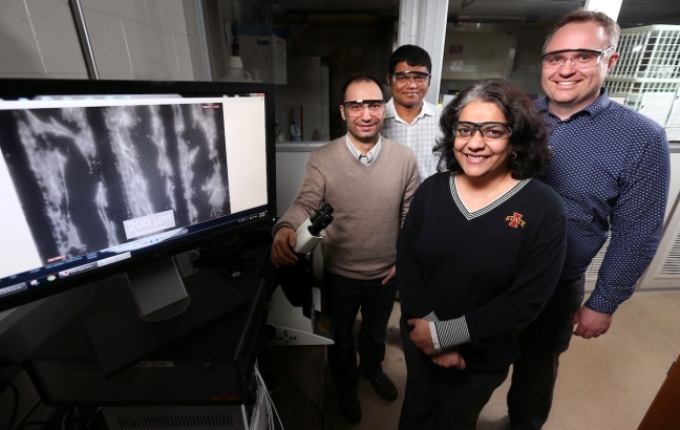Apr 11 2017
 Iowa State University researchers, left to right, Metin Uz, Suprem Das, Surya Mallapragada and Jonathan Claussen are developing technologies to promote nerve regrowth. The monitor shows mesenchymal stem cells (the white) aligned along graphene circuits (the black). CREDIT: Photo by Christopher Gannon.
Iowa State University researchers, left to right, Metin Uz, Suprem Das, Surya Mallapragada and Jonathan Claussen are developing technologies to promote nerve regrowth. The monitor shows mesenchymal stem cells (the white) aligned along graphene circuits (the black). CREDIT: Photo by Christopher Gannon.
Scientists searching for the means to regenerate nerves might find it difficult to acquire the important tools needed for research. One such example is Schwann cells that form sheaths enclosing axons, which are tail-like portions of nerve cells that convey electrical impulses. In addition to promoting regeneration of the axons, the Schwann cells discharge substances, boosting the health of nerve cells.
To put it differently, the Schwann cells prove to be helpful to researchers working towards the regeneration of nerve cells, particularly peripheral nerve cells located outside the spinal cord and brain. However, the count of Schwann cells is too low to be of any use.
Scientists have been using noncontroversial, readily available mesenchymal stem cells — that is, bone marrow stromal stem cells with the ability to form cartilage, bone, and fat cells — by differentiating them into Schwann cells by means of a chemical process. Unfortunately, this process is costly and laborious.
The Iowa State University research team have been looking for a better way to transform the stem cells into Schwann-like cells, and have created a nanotechnology that employs inkjet printers for printing multi-layer graphene circuits. It also employs lasers to treat and enhance conductivity and the surface structure of the circuits.
The mesenchymal stem cells have been found to adhere and grow in a better manner on the rough, raised, and 3-D nanostructures of the treated circuit. When small doses of electricity of about 100 mV were applied for 10 minutes per day, for a time period of 15 days, the stem cells transformed into Schwann-like cells.
This discovery has made it to the front cover of Advanced Healthcare Materials, a scientific journal. The lead author of the study is Jonathan Claussen, assistant professor of mechanical engineering at Iowa State University and an associate of the U.S. Department of Energy’s Ames Laboratory. The first authors of the study are Suprem Das, a postdoctoral research associate in mechanical engineering and an associate of the Ames Laboratory, and Metin Uz, a postdoctoral research associate in chemical and biological engineering.
The research has been funded by the Roy J. Carver Charitable Trust, the U.S. Army Medical Research and Materiel Command, and Iowa State’s College of Engineering, including the Department of Mechanical Engineering. The research has also been supported by The Carol Vohs Johnson Chair in Chemical and Biological Engineering, Surya Mallapragada. She is a co-author of the study, an Anson Marston Distinguished Professor in Engineering, as well as an associate of the Ames Laboratory.
This technology could lead to a better way to differentiate stem cells. There is huge potential here.
Metin Uz
When compared to the standard chemical process with the ability of differentiating only 75% of the stem cells into Schwann-like cells, the highly effective electrical stimulation carried out in the new technique can differentiate 85%. In addition, the electrically differentiated cells generated a nerve growth factor of 80 ng/mm when compared with 55 ng/mm in the case of the chemically treated cells.
The research team believes the outcome might result in changes in the ways nerve injuries are cured inside the body.
These results help pave the way for in vivo peripheral nerve regeneration, where the flexible graphene electrodes could conform to the injury site and provide intimate electrical stimulation for nerve cell regrowth.
The research team
Various benefits of using electrical stimulation for transforming stem cells into Schwann-like cells are reported in the paper:
- Eliminating the laborious steps involved in chemical processing
- Minimizing the cost of differentiation by avoiding the requirement of costly nerve growth factors
- Positively enhancing the stem cell differentiation control by means of accurate electrical stimulation
- Developing a low-maintenance, artificial framework for the treatment of neural damage
A graphene inkjet printing process, created in Claussen’s research lab, is an important part of making the process work. Flexible, inexpensive, and wearable electronics can be produced through the process by making appropriate use of the benefits of wonder-material graphene, namely high stability, high strength, biocompatibility, and higher electrical and heat conductivity.
The research team confronted one major challenge — after printing the graphene electronic circuits, the circuits mandated further treatment to enhance the electrical conductivity, normally done using chemicals or high temperatures. Both of these methods can damage the flexible printing surfaces which include paper or plastic films.
Claussen and his colleagues overcame the challenge by developing a computer-controlled laser technology with the ability to selectively irradiate inkjet-printed graphene oxide. This step eliminates ink binders and converts the graphene oxide to graphene by physically connecting millions of tiny graphene flakes together. This improves the electrical conductivity by over a thousand times.
The cooperation between Claussen’s team of nanoengineers (who developed printed graphene technologies), and Mallapragada’s team of chemical engineers (who investigated nerve regeneration), started as a consequence of informal conversations on campus.
This resulted in experimental efforts to grow stem cells on printed graphene and then to perform electrical stimulation experiments.
We knew this would be a really good platform for electrical stimulation. But we didn’t know it would differentiate these cells.
Suprem Das
Since the process has been successful in differentiating the stem cells, the scientists believe that there may be further prospective applications to consider. For instance, in future, the technology could be applied to develop absorbable or dissolvable nerve regeneration materials. These could be surgically positioned inside a patient’s body without the need for subsequent surgery to remove the materials.